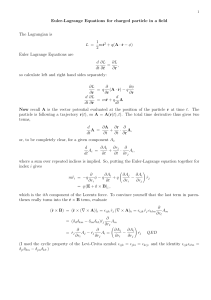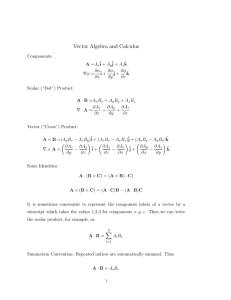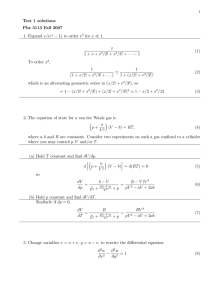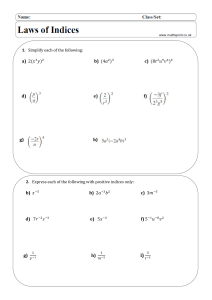Introduction to Indicial Notation
advertisement
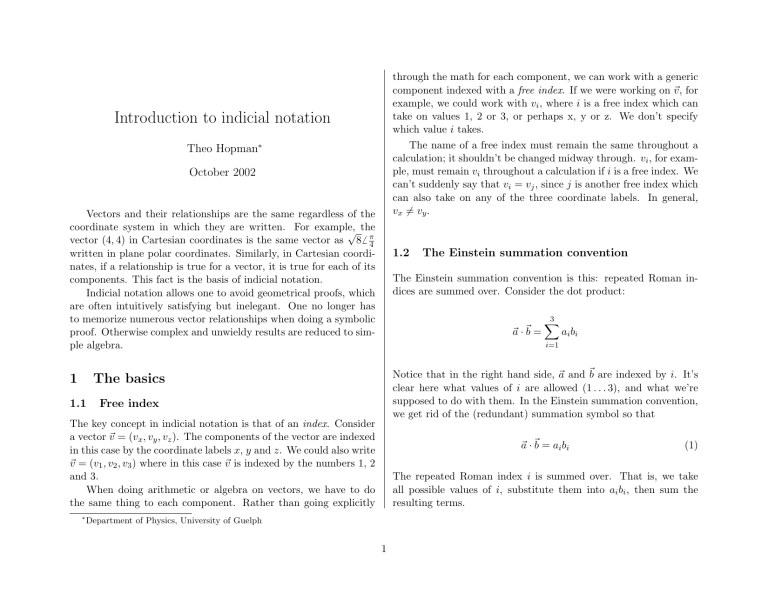
through the math for each component, we can work with a generic
component indexed with a free index. If we were working on !v , for
example, we could work with vi , where i is a free index which can
take on values 1, 2 or 3, or perhaps x, y or z. We don’t specify
which value i takes.
The name of a free index must remain the same throughout a
calculation; it shouldn’t be changed midway through. vi , for example, must remain vi throughout a calculation if i is a free index. We
can’t suddenly say that vi = vj , since j is another free index which
can also take on any of the three coordinate labels. In general,
vx "= vy .
Introduction to indicial notation
Theo Hopman∗
October 2002
Vectors and their relationships are the same regardless of the
coordinate system in which they are written. For example,
√ the
vector (4, 4) in Cartesian coordinates is the same vector as 8" π4
written in plane polar coordinates. Similarly, in Cartesian coordinates, if a relationship is true for a vector, it is true for each of its
components. This fact is the basis of indicial notation.
Indicial notation allows one to avoid geometrical proofs, which
are often intuitively satisfying but inelegant. One no longer has
to memorize numerous vector relationships when doing a symbolic
proof. Otherwise complex and unwieldy results are reduced to simple algebra.
1
The basics
1.1
Free index
1.2
The Einstein summation convention is this: repeated Roman indices are summed over. Consider the dot product:
!a · !b =
3
!
ai bi
i=1
Notice that in the right hand side, !a and !b are indexed by i. It’s
clear here what values of i are allowed (1 . . . 3), and what we’re
supposed to do with them. In the Einstein summation convention,
we get rid of the (redundant) summation symbol so that
The key concept in indicial notation is that of an index. Consider
a vector !v = (vx , vy , vz ). The components of the vector are indexed
in this case by the coordinate labels x, y and z. We could also write
!v = (v1 , v2 , v3 ) where in this case !v is indexed by the numbers 1, 2
and 3.
When doing arithmetic or algebra on vectors, we have to do
the same thing to each component. Rather than going explicitly
∗
The Einstein summation convention
!a · !b = ai bi
(1)
The repeated Roman index i is summed over. That is, we take
all possible values of i, substitute them into ai bi , then sum the
resulting terms.
Department of Physics, University of Guelph
1
1.3
By even permutation I mean that ijk is one of 123, 231 or 312.
We see that these three combinations require an even number of
swaps of indices to return them to 123, and that they are cyclic
permutations of each other. For example, if we swap the first two
indices in 312, we get 132. If we then swap the last two, we get
123, a total of two swaps, meaning that 312 is an even permutation
of 123.
Just as there are three cases where #ijk is +1, there are three
cases where it is −1. In these cases, ijk is one of 132, 321 or 213.
You should be able to convince yourself that each of these combinations can be returned to 123 with and odd number of permutations.
For example, 321 → 231 → 213 → 123. These three combinations
are cyclic permutations of each other as well.
A property of #ijk is that
Dummy indices
An index which does not appear in an equation after a summation is carried out is called a dummy index. Because a dummy
index does not appear in the final result,
we can"change its name
"3
to whatever is convenient. Just as i=1 ai bi = 3j=1 aj bj , so also
ai bi = aj bj .
2
Necessary functions
There are two functions which are extremely useful in indicial notation: the Kronecker δ function and the Levi-Civita # function.
2.1
The Kronecker δ
#ijk = −#ikj
The Kronecker δ (delta) function is defined very simply:
#
0 if i "= j,
δij =
1 if i = j.
since one side of the equation is an even permutation and the other
is an odd permutation. (We can’t say specifically that the left hand
side is an odd permutation because ijk are free indices and may
each take any value.)
(2)
Notice that both i and j are free indices here, and may each take
on any value. Only for the three possible cases where i = j is δij
non-zero. Note that δij = δji .
Consider: why does δii = 3, not 1?
2.2
2.3
Relating δ and "
A very useful identity is
#ijk #ilm = δjl δkm − δjm δkl
The Levi-Civita "
(5)
This identity can be proved exhaustively, but we won’t do that here
since there are 34 = 81 possible combinations of the free indices j,
k, l and m, each of which has three terms in the implied sum over
i. Instead, let’s observe some features of the identity.
First of all, there is a dummy index i on the left hand side; this
index is repeated, so it’s summed over and doesn’t appear on the
right hand side. Any time you see two # symbols with the same index, you can use this identity. It may be a little easier to use if you
The Levi-Civita # (epsilon) function is rather more complicated,
since it is a function of three free indices, meaning there are 27
possible combinations. However, it can be summarized as
if any of i, j or k are the same,
0
#ijk = +1 if ijk is an even permutation of 123,
−1 if ijk is an odd permuation of 123.
(4)
(3)
2
first put the # symbols in the form above using cyclic permutation
and (4).
Second, as a mnemonic device, notice that the indices on the
deltas in first term on the right hand side are “parallel”, while
those on the deltas in the second term are “crossed”. The diagram
below may be helpful in seeing this.
ply the Einstein summation convention, we end up with (as we
saw above)
!a · !b = ai bi
3.2
The magnitude of a vector is closely related to the dot product.
We can write
(
)1/2
1/2
|!v | = v = !v · !v
(6)
= vi vi
δjl δkm − δjm δkl
j
k
j
k
l
m
l
m
3.3
3.1
The cross product
Not surprisingly, the cross product is also represented easily with
indicial notation; it is associated with the epsilon symbol. The
following identity
(!a × !b)i = #ijk aj bk
(7)
The first delta uses the first free index from each epsilon; the second uses the second free index from each epsilon. The third delta
uses the first free index from the first epsilon and the second from
the second, while the fourth uses the converse. Of course, within
each term, the delta may be written in either order, and within
each delta, the indices may be written in any order.
3
Magnitude
gives us the ith component of the cross product !a × !b. Let’s illustrate this by choosing a specific value for i, say 2, corresponding to
the y component of the cross product. With i = 2, we’ll carefully
and slowly evaluate the right hand side of (7). First we explicitly
write the (implied) sums, and evaluate one of them.
Vector operations
#2jk aj bk =
#2jk aj bk
j=1 k=1
The dot product
=
We saw above in §1.2 that the dot product can be represented easily using indicial notation. We can associate the dot product with
the Kronecker delta as follows:
!a · !b =
3 !
3
!
3 !
3
!
3
!
j=1
{#2j1 aj b1 + #2j2 aj b2 + #2j3 aj b3 }
But the #2j2 term is zero since two of its indices are identical. We
can sum each term separately.
ai bi δij
i=1 j=1
=
By applying the properties of the Kronecker delta (zero unless
i = j), we can replace all the j’s we see with i’s. When we ap-
3
!
j=1
3
#2j1 aj b1 +
3
!
j=1
#2j3 aj b3
Clearly in the first sum, the only possible value of j which gives
a non-zero #2j1 is j = 3. Similarly, only j = 1 in the second sum
gives a non-zero term.
These terms all look very similar, except for the indices 1, 2 and
3. In fact, we can write this as a sum.
= #231 a3 b1 + #213 a1 b3
=
= +a3 b1 − a1 b3
ai #ijk bj ck
i=1
= ai #ijk bj ck .
Therefore the y component of !a × !b is given by
This is just the scalar triple product, which is readily seen:
(!a × !b)y = az bx − ax bz .
(
)
!a · (!b × !c) = ai !b × !c i = ai #ijk bj ck .
as we expect. If you wish, you can work through the similar algebra
for the x (i = 1) and z (i = 3) components.
3.4
3
!
3.5
Determinants and the scalar triple product
The ∇ operator
! operator. Since ∇
!
Indicial notation can also be used with the ∇
is an operator, not just a number, special care must be taken to
keep the order of operations. That is, everything to the right of
the operator must stay to the right of the operator.
The notation ∇i is short for “take the partial derivative of what
follows with respect to the ith component of !r”. That is,
Determinants and the scalar triple product are identical, and can
be written in indicial notation. Suppose we wanted to find the determinant of the 3 × 3 matrix composed of the vectors !a, !b and !c.
The determinant is
*
*
*a1 a2 a3 *
*
*
* b1 b2 b3 * = a1 (b2 c3 − b3 c2 ) + a2 (b3 c1 − b1 c3 ) + a3 (b1 c2 − b2 c1 )
*
*
* c1 c2 c3 *
∇i ≡
You will notice that the parenthesized factor in the second term
on the right hand side is identical (save for the change of variables
a → b and b → c) to the results for the y component of the cross
product. Similarly, the factors in parentheses in the first and third
terms can be identified with the x and z components of the cross
product. (This shouldn’t be surprising, since one way of finding a
cross product is via a construction similar to a determinant.) We
can therefore substitute these cross product components in.
∂
∂ri
where i is a free index which selects differentiation with respect to
x, y or z.
The familiar gradient, divergence and curl are written as
! = ∇i f,
∇f
! · !v = ∇i vi and
∇
! × !v = #ijk ∇j vk .
∇
= a1 #1jk bj ck + a2 #2jk bj ck + a3 #3jk bj ck
4
(8)
(9)
(10)
Since we haven’t said what component i is, this equation
must be true for all components. Therefore,
(
)
(
)
(
)
!a × !b × !c = !a · !c !b − !b · !c !a
Q.E.D.
Let’s look a little more closely at, for example, the divergence.
! · !v = ∇i vi
∇
=
3
!
i=1
∇i vi
2. Show that
( )
) (
) ( )
(
!a × !b × !c × d! = !a!cd! !b − !b!cd! !a
∂
∂
∂
=
v1 +
v2 +
v3
∂r1
∂r2
∂r3
( )
where !a!b!c ≡ !a · !b × !c.
But r1 , r2 and r3 are just x, y and z respectively.
Recall that !a · !b × !c − ai #ijk bj ck . We can therefore write the
right-hand side in indicial notation:
∂
∂
∂
v1 +
v2 +
v3 .
∂x
∂y
∂z
So we see that indicial notation gives us back the familiar form for
the divergence.
=
4
RHS = bi aj #jkl ck dl − ai bj #jkl ck dl
(
)
= bi aj − ai bj #jkl ck dl
We can’t go much further here, so let’s work with the lefthand side.
(
) (
)
LHS = #ijk !a × !b !c × d!
Some worked examples
1. Show the vector triple product identity
(
)
(
)
(
)
!a × !b × !c = !a · !c !b − !b · !c !a.
j
= −#jik #jlm al bm #knp cn dp
(
)
= − δil δkm − δim δkl al bm #knp cn dp
(
)
= − ai bk − bi ak #knp cn dp
(
)
= bi ak − ai bk #knp cn dp
We need only look at one component, which we do not specify, but identify with the free index i.
+(
,
)
(
)
!a × !b × !c = #ijk !a × !b j ck
i
= #ijk #jlm al bm ck
We are in fact now done, even though this doesn’t look exactly like the right-hand side. The differences, however, are
merely dummy variables, whose names we are free to change.
If we make the change of dummy variables k → j, n → k and
p → l, we get
(
)
= bi aj − ai bj #jkl ck dl
= #jki #jlm al bm ck
by cyclic rearrangement
(
)
= δkl δim − δkm δil al bm ck
by identity (5)
We can multiply this out and then apply the Kronecker
deltas. Recall that the delta has the effect of forcing indices
to be the same (otherwise the term is zero).
= ak bi ck − ai bk ck
+(
)
(
) ,
= !a · !c !b − !b · !c !a
k
= #ijk #jlm al bm #knp cn dp
= RHS
and the proof is complete.
i
5
( )
(
)
! ·A
! .
! · φA
! = ∇φ
! ·A
!+φ ∇
4. Show that ∇
3. Show that if !a + !b + !c = 0, !a × !b = !b × !c = !c × !a.
We need to show two equalities for a complete proof, but
since they are done in almost exactly the same way, we’ll do
only one here.
!a × !b = #ijk aj bk
(
)
= #ijk aj −ck − ak
! i.
This is trivial in indicial notation. Note that ∇i φ = (∇φ)
( )
( )
! · φA
! = ∇i φA
∇
in indicial notation
(
) i
= ∇i φ Ai + φ∇i Ai by the product rule
( )
(
)
!
!+φ ∇
! ·A
!
= ∇φ
·A
= −#ijk aj ck − #ijk aj ak
The second term in zero, since it corresponds to !a × !a.
= #ikj ck aj
(
)
! r̂.
5. Evaluate r̂ · ∇
= !c × !a
6
